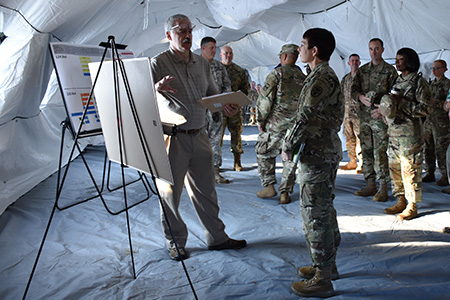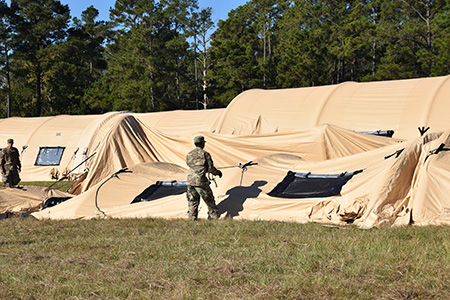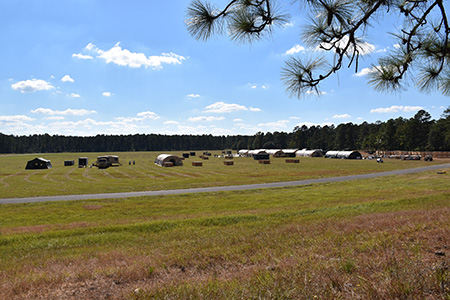New Field Hospital Equipment Verification Event Held at Fort Polk



Over the duration of two hot and humid weeks on an expansive parade ground field, the U.S. Army Medical Research and Materiel Command's U.S. Army Medical Materiel Development Activity conducted a non-medical equipment verification exercise with support from the 115th Combat Support Hospital at Fort Polk, Louisiana. USAMMDA led the exercise in coordination with the Army Medical Department Center and School/Health Readiness Center of Excellence, Capabilities Development Integration Directorate, the AMEDD Board, and the U.S. Army Medical Materiel Agency.
The new field hospital is modular in concept, consisting of smaller sections that build into a larger hospital configuration. The hospital starts with a 32-bed early entry section, which provides hospitalization and outpatient services in support of deployed forces. Next, either the surgical capabilities are expanded with a 24-bed capability, or intensive and intermediate medical care is increased with a 32-bed expansion. Finally, a 60-bed intensive care capability is added depending on what is required at the time.
During the course of the verification exercise, the two resulting 116-bed and 124-bed configurations were established including Tent Extendable Modular Personnel air-supported shelters, rigid wall shelters, and power and water infrastructure to verify the non-medical equipment requirements.
"The layout of the power and water is the main focus of the exercise," said Jaime Lee, USAMMDA Medical Support Systems Project Management Office product manager. "Documenting that is important."
For the water/waste water configuration, information gathered during this event was needed to make sure there were enough hoses and fittings necessary to make new medical equipment sets into the modular components that now make up the new field hospital design.
The power team needed to make sure there was enough Power Distribution Illumination System electrical equipment to support the new field hospital conversion, which refers to the military family of power distribution equipment.
Maj. Gen. Barbara R. Holcomb, USAMRMC commanding general and chief, U.S. Army Nurse Corps, visited the site for a day during the exercise along with Col. William Geesey, USAMMDA commander, to see the work in progress.
Col. Maria Summers, chief nurse, 115th CSH, spoke about how things worked on Fort Polk and introduced personnel from the 115th staff who took part in the exercise. A few of them provided input into what goes into their daily experiences and how they could gain and lend knowledge and support to the exercise.
Holcomb, having served in a few field hospitals herself, including the 47th CSH during Desert Storm, stressed the importance of going through the training of employing a field hospital, including integrating power and water.
"This is the environment that I love; I spent a lot of time in it," said Holcomb.
During the tour, Lee pointed out the Rigid Wall Shelters and explained the need for Retrofit kits in order to address inadequacies of the ageing shelters. He mentioned three main benefits of the kits: the carbon-composite material allows for more floor stability and minimizes vibration during surgery; the containers can stack nine-high, which lessens shipping costs; and Tnemec's Aerolon 945 will be applied to the ceiling, which will help provide better insulation, thereby reducing heat and cold loss through the top of the shelter. The USAMMDA will begin retrofitting shelters in fiscal year 2017.
According to Lee, an additional item available for the TEMPER air-supported shelters is a solar shade which reduces the solar loading by 90 percent. It is laid over the top of the shelter before it is deployed. The newer 32-foot tents displayed onsite are 10 inches shorter than the current tents to accommodate the new collective protection liners, which can be used in case of a chemical or biological attack.
Having attended the briefing and seen the deployment of a TEMPER air-supported shelter, Holcomb indicated that she was impressed that a 64-foot section of the shelter had just been inflated in about 15 minutes as she stood and watched.
In addition, Holcomb said, "There is a huge improvement in the material being lighter and more air tight. It offers better infection control, as the old TEMPER could get sand in it. It was also much more labor intensive."
All of the improvements, now available to the shelters themselves, are excellent additions to the new modular concept in providing a better way of organizing and providing hospitals to troops in the field.













